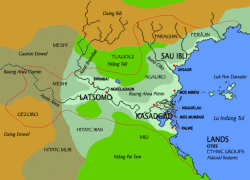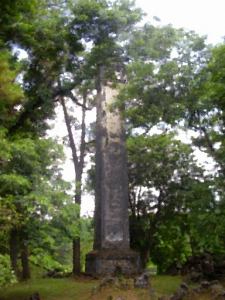Ndak Empire
| Ndak Empire lu Ospâk Ndak | |

| |
| Capital | Mos Mumbasi |
| Major cities | Mos Mindu Ngaurlau Ngkeladadn |
| Languages | Ndak Ta |
| Demonym | Ndak |
| Government | monarchy |
| Formation | c. -2000 YP |
| Collapse | c. -1200 YP |
| Successor states | city states of Kasca and Lasomo |
| Credits | |
| Created by | Radius |
| Edit me | |
The Ndak Empire was the first large empire of Peilaš, centered on Kasadgad. At its height around -1900 YP, the empire encompassed the whole lower and middle Aiwa valley, the Rathedān highlands, and the coast up to the Čisse river in the north and the Şepamã river in the south.
History
The rise of the Ndak
The Ndak originally lived along the middle Aiwa. They were briefly ruled by the Ngauro, but soon established a kingdom of their own. They fought several wars with the Ngauro and finally conquered them. Over time the Ngauro language was replaced with Ndak Ta, and indeed the perceived center of the Ndak world shifted to the more populous delta. The Ndak in their turn were conquered (once by hill tribes from the north, twice by nomads from the west), but their edge in population had become secure; they eventually either revolted, or absorbed their conquerors.
After the Ndak expelled the last of the conquerors, they entered a new period of vigor, which culminated in the conquest of the entire Aiwa plain, the littoral, and much of the rugged mountains to the west, from their bases in Kasca and along the Aiwa. The Ndak Empire was the first true empire on Akana, at least in this part of the world. Much of this was the work of one dynasty of emperors; Tsinakan was the third in this line and perhaps the greatest of them all. Tsinakan is the subject of the infamous Tsinakan text, the standard comparison text used among Edastean philologists. His father Terakan also found a lasting place in local legend, though historians pay less attention to him.
Decline and fall
The Ndak decline took time. Kasadgad hung on as a political entity for several centuries after having lost control over everything else. It was late in this period, in -1258 YP, that Kasadgad experienced a last gasp of vitality, managing to reconquer both the Huyfárah littoral and most of the Aiwa below Lasomo. Two of these latter-day kings, Sadgukiyat and his son (or maybe nephew) Meyut, were recorded in legend and song. Historians have difficulty piecing together the fragmentary accounts of other kings of this era, and nobody is entirely certain who they all were, nor about the accession dates of these two or any reliable description of their accomplishments. If it weren't for the Faraghin scribes of this era, we may not even have been sure that these two were more than mythical figures.
The final full loss of Ndak vitality is partly due to a natural disaster, although they were clearly already in serious decline. In -1202, Kasadgad was devastated by one of the rare major hurricanes to come ashore along its coast. Complete loss of many of the coastal towns, coupled with massive inland flooding, nailed shut the coffin on Ndak power. They lost control of all of the coast above Miədu and all the Aiwa river above Buruya, and with the resulting social chaos found themselves unable to maintain any overall societal structure. And to top it all off, due to poor maintenance their canal through the Aiwa delta had silted up, blocking navigation of the delta and thus choking off Kasadgad's economic lifeline.
Culture
As the sample text indicates, Kasadgad has many gods, with a special emphasis on the sun and moon, and the goddess Ombàsi. 'God' is an open-ended category; kings become gods upon their deaths.
The Ndak themselves are agricultural, dependent on the bounty of the Aiwa and the sea. The people live largely on grains and seafood-- meat is a luxury and full of religious significance. Wild animals are largely extinct in the Aiwa valley, and devoting alluvial land to pasture is a great luxury, so sheep are few, though they may be acquired through trade. Oxen are used for plowing, while cows are valued for providing milk and dung (used for fuel and for building). Horses are not native to the region, though the western nomads have mastered them.
In the delta, houses are normally made of dried mud; upriver, of wood. Fine buildings in both areas are made of wood and stone.
The Ndak are a very stratified society: the kings at the top, priests and nobles below them, then peasants, then a large class of slaves. The economy is centrally directed; all land belongs to the king, though nobles have the right of inheritance; officials direct everything from planting to craft work. There are no markets; trade is a matter of large-scale barter between kings-- under the empire, it is organized by the state.
The nobility is trained for war; they are the core of the Ndak army, though it relies heavily on the military skills of the conquered peoples (e.g., westerners form the cavalry).
Though Ndak mores are brutal by our standards-- the criminal code relies heavily on amputating offending members; conquered cities are sacked and the citizens enslaved; the nobles are polygamous; human sacrifice is common-- the duty of kings is to bring order and prosperity. Outside of wartime, there is little to fear from lawlessness or banditry. Nobles and priests cultivate the arts (music, poetry, sculpture) and the useful sciences (astronomy, herblore, metallurgy, soothsaying).

